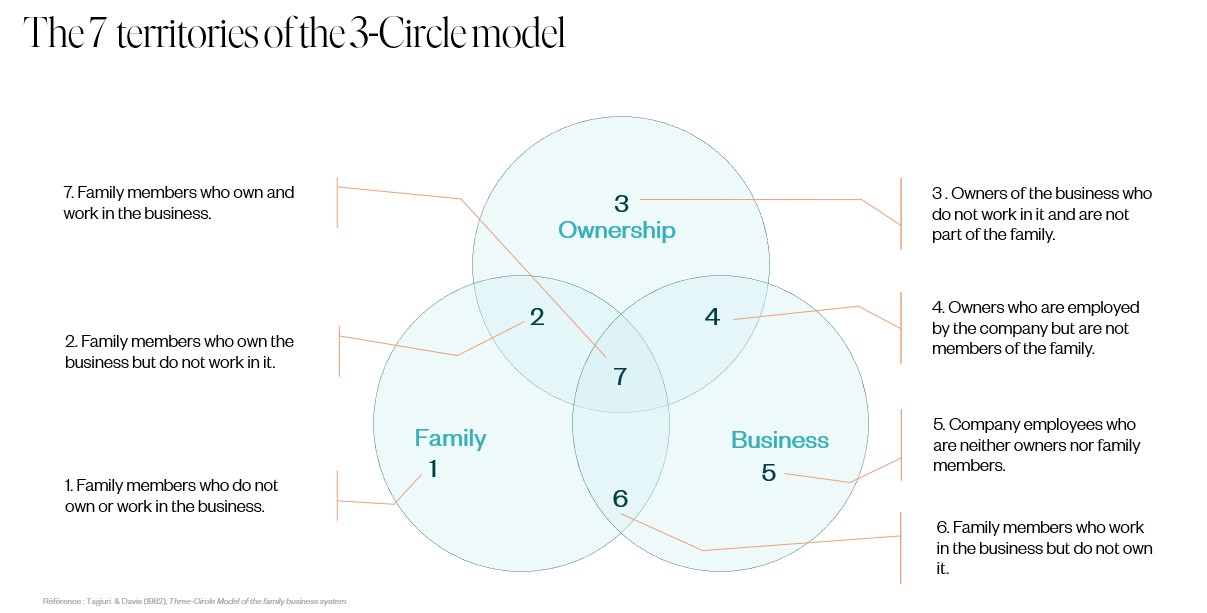The Three-Circle Model: A Powerful Lens for Understanding Enterprising Family Dynamics

Family dynamics are inherently complex, and even more so for enterprising families. Balancing personal relationships with professional roles introduces unique challenges, such as succession planning, governance, and financial decision-making, all while trying to preserve family bonds.
The Three-Circle Model remains a foundational and resilient framework for understanding the overlapping roles in the business family system. It continues to offer valuable guidance for navigating dynamics, conversations, and decision-making. While newer models have since been developed, many build upon the strength and clarity this enduring model provides.
One of its biggest strengths is helping families understand that many tensions aren’t personal - they’re structural. Conflict often comes from the different “hats” people wear, not personality clashes. That shift in perspective can make all the difference when navigating tough conversations or decisions.
What is the Three-Circle Model?
Developed by Tagiuri and Davis in 1978, the Three-Circle Model has become the go-to framework for making sense of business families. It breaks things down into three overlapping circles—Family, Ownership, and Business—offering a simple visual representation that helps clarify roles and positions within the business family system.
The model highlights the interdependence between the three circles and demonstrates how the business family system doesn’t function as separate parts — it emerges from dynamic interactions among all three. Change in one area inevitably impacts the others. A family conflict might shake up leadership, while an ownership transition could influence both family harmony and business continuity.
In this way, the business family operates as a system—one where the whole is truly greater than the sum of its parts, yet distinct from each other. And that’s precisely what makes this model both timeless and still relevant today.
Understanding Each Circle
The model visually plots family members, helping them understand their relative position to others and how their perspective is shaped by where they sit within the family dynamic. Generally, family members will occupy a role within an intersection of multiple circles.
Ownership Circle
The Ownership Circle centers on the financial interests and responsibilities of those with legal ownership in the family business. While these individuals may not be involved in daily operations, they hold a stake in the business's success. Key focus areas include stewardship, ownership succession, voting rights, asset management, and dividend policies.
The circle also emphasizes that ownership is learned, not inherent. As the family grows, it addresses non-financial goals such as emotional ties, family identity, values alignment, and varying levels of involvement.
Business Circle
The Business Circle focuses on the operational aspects of the family enterprise, encompassing day-to-day decision-making, management, strategy, market competitiveness, and growth. The nature of the business circle may vary and may represent one or more operating companies, a family office, or a holding company, for example. It includes family members who work in the business, as well as non-family executives and employees. Challenges in this circle can arise when personal relationships interfere with business decisions or when the family interests conflict with what's best for the business.
Family Circle
The Family Circle focuses on relationships, legacy, and emotional bonds. It emphasizes shared values, continuity, and preparing future generations for involvement. This circle includes all family members—whether or not they work in the business—and is shaped by personal relationships, family dynamics, and a commitment to long-term connection and purpose.
The definition of who belongs in the Family Circle differs for each family, based on their established criteria (e.g., birth, marriage, adoption, common-law relationship). This circle also encourages reflection on how family members are connected—whether dependent, interdependent, or independent.

The 7 Territories of the Business Family System
The Three-Circle Model identifies seven territories among which individuals may position themselves. Individuals may have unique roles, perspectives, and interests depending on their position. The three main territories relate to individuals who fall within one of the circles exclusively. They can be:
-
Non-Family Owners in Territory 3: Individuals within the Ownership Circle only. Their main concerns usually revolve around financial returns, governance, and the long-term health and success of the business.
-
Non-Family Employees in Territory 5: Individuals within the Business Circle only. Their interests typically focus on job security, career growth, fair compensation, and a stable work environment, as they navigate the complexity of family relationships that may impact them.
-
Family Members in Territory 1: Individuals within the Family Circle only. Their interests often center around family dynamics, values, and legacy, as well as the balance between family and business life.
An additional four territories exist at the intersections of the circles, where you will have:
-
Family Owners in Territory 2: Individuals positioned at the intersection of the Family and Ownership Circles. Their interests are often a blend of business performance, wealth management, legacy preservation, and family harmony.
-
Family Employees in Territory 6: Individuals positioned at the intersection of the Family and Business Circles. They typically have a vested interest in both the business's success and the family's legacy. They may face unique challenges, such as balancing family relationships with professional responsibilities, and are often key players in maintaining the family’s values within the business.
-
Non-Family Owner Employees in Territory 4: Individuals positioned at the intersection of the Business and Ownership Circles. Their interests often involve maintaining a strong voice in the business's direction, ensuring fair compensation, and navigating the dynamics between family owners and non-family employees.
-
Family Owner Employees in Territory 7: Individuals positioned at the central intersection of all three circles. Their interests tend to focus on ensuring the success and continuity of the business while navigating the challenges of wearing all three hats —family member, owner, and employee—and balancing personal and professional interests.
Evolution of the Model
While the Three-Circle Model remains a powerful starting point, it doesn’t always capture the full complexity of family life and evolving realities. Family needs, concerns, and dynamics often spill beyond the boundaries of Family, Ownership, and Business as defined in the original model. That’s why some scholars and practitioners have proposed variations, most notably, introducing a Fourth Circle.
Scholars, including Mikoláš & Karpeta (2016) and Bartczak (2019), build upon the three-circle model reworking how multi-generational success can create its unique development strategy around a unifying purpose. The four circles represent the family, the family business, the family wealth and/or business outcomes, and the environment. The environment illustrates the different generational perspectives and needs that can impact the other circles influencing the ability of the business family to align their goals and purposes. Business families who successfully articulate and implement shared purposes demonstrate an enhanced capacity to balance economic performance with social and non-financial goals.
Defining a shared purpose creates a breathing space between ownership, business, and family circles, serving as a buffer when mutual challenges arise among family stakeholders. By identifying these challenges and developing contingency plans aligned with family values, legacy stakeholders cultivate a strong sense of purpose and meaning that unifies them while adapting to changing circumstances.
These evolving models can offer deeper insights and help ensure the framework stays relevant and responsive to the unique and changing needs of each business family.
How These Models Help Enterprising Families
- Developing a Systematic Perspective: Families can develop a more holistic and systematic perspective on how their business family goals, decisions, and priorities align across their complex realities.
- Defining Roles and Structure: These models help families understand their current structure while providing a blueprint for the future. They allow families to anticipate how evolution may introduce new needs, dynamics, conversations, and governance mechanisms. Each family's blueprint will look different and evolve over time, shaped by the enterprise's complexity, maturity, and needs.
- Facilitating Crucial Conversations: The model opens the door to crucial conversations about who belongs in each circle, what privileges and responsibilities exist, how to prepare for transitions between circles, and what goals and challenges define each circle. It fosters awareness of different perspectives family members may have depending on their position, helping to clarify and address sources of friction proactively.
- Aligning Governance with Needs: These models help identify necessary governance mechanisms and practices to achieve family goals and reduce challenges. They offer opportunities to plan strategic activities with greater precision, such as exploring role distribution, developing succession strategies, addressing the transmission of values, and identifying potential risks or blind spots.
In conclusion, the models we’ve discussed are more than just guidelines—they’re living tools that evolve alongside your family. By illuminating the intricate dynamics of relationships and structures, families can come together around common goals while appreciating each person's unique role and journey. When you apply these models with intention, they spark deeper conversations, enhance governance, and foster lasting continuity grounded in purpose and trust.